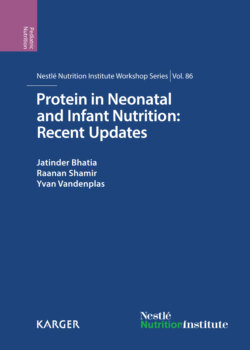Читать книгу Protein in Neonatal and Infant Nutrition: Recent Updates - Группа авторов - Страница 7
На сайте Литреса книга снята с продажи.
Preface
ОглавлениеProteins play a crucial role in the growth and development of children. During the last decade, a deeper understanding has been achieved of the role of proteins in infant feeding as well as short- and long-term consequences of inappropriate protein intake in infancy. The 86th Nestlé Nutrition Institute (NNI) Workshop, which took place in Beijing (China) in May 2015, has focused on the recent updates on the role of protein in neonatal and infant nutrition.
The first session was dedicated to the role of hydrolyzed protein in infant feeding. The presentations were designed in a way to cover the characteristics of hydrolysates and the rationale of using the appropriate hydrolysate for healthy infants as well as infants with special dietary requirements. It was stressed that partially hydrolyzed infant formulas can significantly reduce the risk of atopic dermatitis in at-risk infants. However, clinical evidence is required for specific hydrolysates as not all hydrolysates are produced in the same way. There is some evidence showing positive benefits of using hydrolyzed protein formulas in infants with functional gastrointestinal disorders and in preterm infants regarding tolerability and digestibility. These benefits should be considered in the clinical context. More research and clinical evidence is required to recommend partially hydrolyzed protein formulas as routine use in such conditions.
The second session of the workshop covered the role of proteins in the feeding of term infants with a special focus on the properties and benefits of human milk. We have discussed in detail the evolution of proteins in human milk, and the importance of using proper methods and technologies in this type of research were emphasized. Breast milk is the ideal nutrition for infants. In non-breastfed babies, there is evidence that infant formula with a lower protein content can reduce weight gain without affecting height in infancy and early childhood. The high quality of the proteins in infant formulas makes it possible to reduce the amounts of protein bringing it closer to the human milk content. This ensures essential amino acid supply sufficient for appropriate growth and development. Functions of human milk bioactive peptides and immunological properties were also discussed. It was concluded that current and new research can bring important information on how proteins can be used in the future in feeding of infants who are not breastfed.
The third session on protein in feeding of preterm infants brought our interest to the arena of human milk fortification and personalized nutrition. It is absolutely clear that human milk is the first option in feeding preterm infants. However, the level of protein and some other nutrients is not sufficient to ensure adequate growth of preterm infants. Adequate growth is beneficial to cognitive development which should be considered as a priority over other health outcomes in this population. Currently, with available human milk fortifiers, adequate growth and accretion similar to that observed in utero is difficult to achieve in preterm infants. In that context, it has been shown that growth of the preterm infant and the fetus is different. The difference could be explained by the different metabolic rate of amino acids. The last topic was on parenteral nutrition, where recent studies have shown that there is no positive correlation between growth and the level of protein provided. Rationale of adding other sources of energy apart from protein should be considered and proven scientifically and clinically.
We would like to thank the distinguished Faculty and all participants for the interesting program and wonderful and stimulating discussions.
On behalf of all participants, we congratulate the Nestle Nutrition Institute on this fantastic workshop, which gave all participants a unique opportunity for learning and discussion.
Jatinder Bhatia
Raanan Shamir
Yvan Vandenplas
